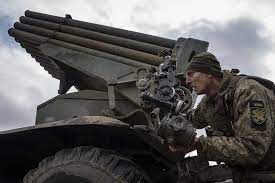KYIV (AP): Ukraine’s capital restored most of its power supply on Friday, officials said, as the country again responded swiftly and defiantly to the latest Russian missile and drone barrage targeting critical infrastructure.
In what has become a familiar Russian tactic since last fall, the Kremlin’s forces struck Ukraine from afar amid months of a grinding battlefield stalemate on the front line in eastern areas. The apparent aim is to weaken Ukraine’s resolve and compel the Ukrainian government to negotiate peace on Moscow’s terms.
Ukrainian authorities scrambled to counter the bombardment’s consequences, part of a recurring cycle of urban smash-and-repair that has brought little change in the course of the war that recently moved into its second year.
The Institute for the Study of War, a Washington-based think tank, said in an assessment that “these missile strikes will not undermine Ukraine’s will or improve Russia’s positions on the front lines.”
Ukrainian military analyst Oleh Zhdanov said the Russians are striking civilian infrastructure, because they can’t efficiently target Ukrainian military assets.
“The Russians lack data about the location of Ukrainian troops and weapons, so they are targeting civilian infrastructure and using the same old methods of attacking civilians to sow fear and panic in the society,” he said. “Ukraine has survived the winter and Russia’s strikes on the energy system in the spring hardly make any sense.”
Power and water were restored in Kyiv, said Serhii Popko, the head of the city’s military administration. Popko said that about 30% of consumers in the capital remained without heating and that repair work was ongoing.
The electricity supply was restored to more than nine in 10 consumers in Ukraine’s northeastern Kharkiv region, local officials said, while power was also restored to a third of consumers in Ukraine’s southern Zaporizhzhia region.
The Russian onslaught was the largest such attack in three weeks, deploying more than 80 Russian missiles and exploding drones.
The barrage, which also damaged residential buildings, killed six people and left hundreds of thousands without heat or running water. The salvo was noteworthy for the range of munitions the Kremlin’s forces used, including hypersonic Kinzhal cruise missiles that are among the most sophisticated weapons in Russian’s arsenal.
Even so, the bombardments on energy infrastructure that gathered pace last fall have become less frequent.
“The interval between waves of strikes is probably growing, because Russia now needs to stockpile a critical mass of newly produced missiles directly from industry,” the U.K. Ministry of Defense said in an assessment Friday.
The Russian Defense Ministry said the strikes were in retaliation for a recent incursion into the Bryansk region of western Russia by what Moscow claimed were Ukrainian saboteurs. Ukraine denied the claim and warned that Moscow could use the allegations to justify stepping up its own assaults.







